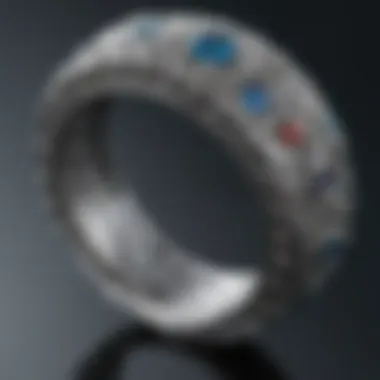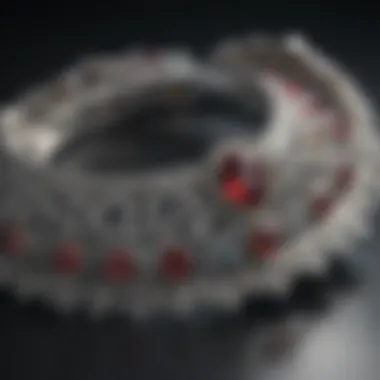Deciphering the Enigmatic World of Silver Jewellery Pricing: A Comprehensive Analysis


Overview of Silver Jewellery Pricing
The realm of silver jewellery pricing is a multifaceted domain that encompasses various intricate factors influencing the cost of these exquisite adornments. By embarking on this exploratory journey, we aim to unravel the enigmatic complexities associated with the valuation of silver jewellery pieces. From the nuanced interplay between material quality to the intricate techniques of craftsmanship, this comprehensive discourse seeks to shed light on the dynamics driving the pricing mechanisms within the world of silver jewellery.
Factors Influencing Silver Jewellery Pricing
Exploring the universe of silver jewellery pricing unveils an array of intricate factors that converge to determine the intrinsic worth of these stunning pieces. Material quality stands as a pivotal cornerstone in the assessment of silver jewellery value, with considerations ranging from the purity of the silver used to the presence of embellishments such as gemstones or intricate engravings. Furthermore, the craftsmanship exhibited in the creation of each jewelry piece holds substantial weight in the pricing equation, with masterful artistry and intricate detailing elevating the overall value of the ornament. Other influential factors may include market demand, brand reputation, and economic conditions that collectively contribute to the pricing landscape of silver jewellery.
Analyzing Material Quality
Delving into the heart of silver jewellery pricing necessitates a meticulous examination of material quality, a crucial determinant of the overall worth of these alluring pieces. Silver purity, commonly measured in terms of fineness or millesimal fineness, plays an instrumental role in ascertaining the value of a silver object. For instance, sterling silver, comprised of 92.5% silver and 7.5% alloy metals, is a prevalent standard in the production of high-quality silver jewellery. Additionally, the presence of hallmark certifications or stamps indicating metal purity further enhances the desirability and value of silver jewellery pieces. By scrutinizing the material composition and purity levels, buyers and enthusiasts can gain valuable insights into the quality and authenticity of silver jewellery items.
Craftsmanship and Artistry
The artistry and craftsmanship infused into the creation of silver jewellery embody a profound impact on the pricing structure of these exquisitely crafted ornaments. Skilled artisans employ a myriad of techniques, from filigree work to granulation and setting gemstones, to embellish silver pieces with intricacy and elegance. The mastery exhibited in intricate designs, precise metalwork, and aesthetic appeal significantly elevate the allure and value of silver jewellery. Moreover, the historical significance of certain craftsmanship styles or distinctive artisan signatures may imbue a piece with added value, reflecting a harmonious blend of artisanship, creativity, and cultural resonance.
Market Trends and Economic Influences
Navigating the realm of silver jewellery pricing entails an acute awareness of prevailing market trends and economic influences that exert significant sway over pricing dynamics. Fluctuations in precious metal markets, such as shifts in silver prices and supply-demand dynamics, directly impact the valuation of silver jewellery items. Furthermore, consumer preferences, fashion trends, and emerging design motifs can shape the demand for specific types of silver jewellery, consequently influencing pricing strategies adopted by manufacturers and retailers. By staying attuned to market fluctuations and consumer sentiment, stakeholders in the silver jewellery industry can adeptly navigate pricing strategies to align with evolving market dynamics and consumer demands.
Understanding Silver Jewellery Pricing
Silver jewellery pricing is an intricate world that requires deep exploration to comprehend fully. In this article, we will dissect the various factors that influence the costs of these exquisite adornments, offering a comprehensive guide for enthusiasts, collectors, jewelry designers, and geology enthusiasts. Understanding the pricing dynamics of silver jewellery is crucial for making informed purchasing decisions and appreciating the value each piece holds. By delving into material quality, craftsmanship, design complexity, market trends, and brand reputation, we aim to provide readers with a nuanced view of what goes into determining the price tags of silver pieces.
Factors Impacting Silver Jewellery Prices
Material Quality
Material quality stands as a cornerstone in the realm of silver jewellery pricing. The grade of silver used, along with any additional materials incorporated, significantly affects the overall cost. Opting for high-quality materials ensures durability and luster, making it a preferred choice for connoisseurs seeking long-lasting pieces. While superior material quality enhances the appeal and longevity of silver jewellery, it may also elevate the price due to the premium nature of these materials.
Craftsmanship
Craftsmanship plays a pivotal role in setting silver jewellery prices apart. The intricate artistry and attention to detail showcased by skilled artisans contribute to the overall aesthetic and value of each piece. Choosing finely crafted jewellery not only exemplifies superior quality but also highlights the dedication and expertise infused into every creation. However, the labor-intensive nature of precise craftsmanship may result in higher price points, reflecting the artisan's skill and the uniqueness of the jewellery.


Design Complexity
Design complexity adds a layer of uniqueness and sophistication to silver jewellery pricing. Intricate patterns, embellishments, and innovative structures elevate the artistic merit of a piece, appealing to discerning buyers seeking originality. While intricately designed jewellery exudes elegance and style, the complexity of these designs can influence pricing. Sophisticated creations often command higher prices, reflecting the innovation and creativity invested in crafting distinctive pieces.
Market Trends
Market trends play a significant role in shaping silver jewellery prices, reflecting current consumer preferences and industry dynamics. Understanding the ebb and flow of market trends allows buyers and sellers to navigate demand and supply fluctuations effectively. By aligning with prevailing trends, jewellery enthusiasts can stay ahead of the curve and acquire pieces that resonate with contemporary sensibilities. However, remaining attuned to market shifts is essential to gauge price fluctuations and make informed purchasing decisions.
Brand Reputation
Brand reputation serves as a key driver in determining silver jewellery prices, reflecting the legacy, prestige, and quality associated with renowned brands. Established brands renowned for exceptional craftsmanship and design often command premium prices due to their heritage and credibility. While opting for reputable brands can guarantee authenticity and superior craftsmanship, it may also entail a higher cost compared to lesser-known alternatives. Investing in branded silver jewellery offers a combination of quality assurance and style recognition, appealing to consumers seeking assurance and prestige in their purchases.
Market Analysis
Global Market Trends
Exploring global market trends provides valuable insights into broader industry movements and influences on silver jewellery pricing. Identifying emerging markets, evolving consumer preferences, and international trade dynamics offer a panoramic view of the global jewellery landscape. By staying informed about global market trends, stakeholders can adapt strategies, anticipate changes, and capitalize on growth opportunities in the international arena.
Regional Variances
Regional variances play a significant role in diversifying silver jewellery pricing, reflecting cultural, economic, and stylistic differences across various regions. Each locale presents unique market demands, traditional design influences, and consumer behaviors that shape pricing strategies. Understanding regional variances enables businesses to tailor their offerings to specific market segments, ensuring resonance with local tastes and preferences. By leveraging regional insights, jewellery stakeholders can strategically position their products and services to cater to diverse markets effectively.
Supply and Demand Dynamics
Navigating the intricate balance of supply and demand dynamics is critical in determining silver jewellery prices. Supply chain disruptions, production costs, and consumer demand fluctuations influence pricing strategies, creating a dynamic pricing environment. Recognizing supply and demand dynamics allows businesses to optimize inventory management, pricing structures, and market positioning to align with changing market conditions. By monitoring supply chains and consumer demands, jewellery stakeholders can adapt swiftly to market shifts and price their offerings competitively.
Historical Price Trends
Evolution of Silver Jewellery Pricing
The evolution of silver jewellery pricing traces the historical trajectory of pricing mechanisms, market trends, and consumer behaviors shaping the industry. Examining the evolution highlights key milestones, innovations, and transformations that have influenced pricing structures over time. Understanding the evolution of silver jewellery pricing provides valuable insights into the industry's resilience, adaptability, and responsiveness to changing market conditions. By charting the evolution, stakeholders can grasp the historical context of pricing dynamics and draw valuable lessons for future strategic decision-making.
Key Influencing Events
Key influencing events have played a significant role in shaping silver jewellery pricing, catalyzing shifts in consumer demand, market positioning, and industry standards. Analyzing these pivotal events sheds light on the moments that have redefined pricing paradigms, spurred innovation, and reshaped market dynamics. By scrutinizing key influencing events, stakeholders can anticipate future trends, mitigate risks, and capitalize on opportunities arising from transformative industry developments. Understanding the impact of key events equips stakeholders with the knowledge needed to navigate the intricate terrain of silver jewellery pricing with foresight and agility.


Evaluating Silver Jewellery Cost Components
Evaluating Silver Jewellery Cost Components is pivotal in gaining a comprehensive understanding of the intricacies of silver jewellery pricing. This section delves into the fundamental aspects that contribute to the overall cost of silver jewellery. By examining the raw materials, labor expenses, and distribution strategies, readers will gain insights into the underlying factors that influence pricing decisions in the industry. Understanding these cost components is vital for both consumers and industry professionals alike as it sheds light on the pricing mechanisms and the value proposition associated with silver jewellery.
Raw Material Costs
Silver Prices
Silver Prices play a crucial role in determining the cost of silver jewellery. The fluctuation in silver prices directly impacts the overall pricing strategy adopted by manufacturers and retailers. The purity and quality of silver used in jewellery production significantly affect the final price point. By analyzing silver prices, stakeholders can assess market trends, anticipate cost variations, and make informed decisions regarding pricing strategies. Despite the volatility of silver prices, its timeless appeal and intrinsic value make it a preferred choice for crafting exquisite jewellery pieces.
Additional Materials
In addition to silver, the inclusion of additional materials further influences the cost of silver jewellery. Precious stones, embellishments, and other materials add aesthetic value and uniqueness to the designs, contributing to the overall pricing structure. The selection of additional materials is a crucial aspect of jewellery making as it reflects the artistic vision of the designer and enhances the perceived value of the piece. However, the cost implications of incorporating additional materials should be carefully evaluated to maintain a balance between creativity and affordability while ensuring quality craftsmanship.
Labour and Overhead Expenses
Artisan Wages
Artisan wages constitute a significant portion of the cost involved in producing silver jewellery. Skilled craftsmen play a vital role in bringing intricate designs to life, investing time and expertise in every piece created. The wages paid to artisans reflect their craftsmanship, experience, and commitment to delivering high-quality jewellery items. While artisan wages contribute to the overall cost, they also signify a dedication to preserving traditional craftsmanship and promoting the cultural heritage associated with silver jewellery production.
Manufacturing Costs
Manufacturing costs encompass the expenses incurred in the production process, including equipment maintenance, utilities, and overhead expenses. Efficient manufacturing practices, streamlined workflows, and quality control measures impact the overall cost efficiency of jewellery manufacturing. By optimizing manufacturing processes and cost allocation, businesses can enhance productivity, reduce production costs, and deliver exceptional value to customers. Striking a balance between manufacturing costs and product quality is essential for sustaining competitiveness in the dynamic jewellery market.
Distribution and Retail Markup
Wholesale vs. Retail Prices
The distinction between wholesale and retail prices is a critical factor in determining the profit margin and market positioning of silver jewellery. Wholesale prices typically apply to bulk orders and transactions between manufacturers and distributors, reflecting the production costs and wholesale margins. Retail prices, on the other hand, cater to individual customers and encompass additional markups for retail overheads, marketing expenses, and profit margins. Understanding the dynamics of wholesale versus retail pricing enables stakeholders to strategize pricing policies, optimize profit margins, and cater to diverse market segments effectively.
Markups in the Industry
Markups in the jewellery industry play a pivotal role in revenue generation and business sustainability. Markup strategies encompass pricing adjustments, promotional offers, and competitive positioning to attract customers and maximize sales. Strategic markup decisions require a thorough analysis of market trends, consumer preferences, and competitive landscape to ensure pricing integrity and brand positioning. While markups contribute to revenue generation, they should align with value delivery, quality standards, and market expectations to build a loyal customer base and drive long-term growth.


Consumer Perspectives on Silver Jewellery Pricing
Understanding the consumer's viewpoint on silver jewellery pricing is crucial in comprehending the dynamics of the market. Customers hold a significant role in determining the success and perceived value of silver jewellery. By analyzing consumer perspectives, one can gain insights into their purchasing behaviors, preferences, and decision-making processes. It allows manufacturers and retailers to tailor their offerings to meet consumer expectations, drive sales, and cultivate brand loyalty.
Perceived Value vs. Actual Cost
Quality Perception
Quality perception plays a pivotal role in shaping consumer attitudes towards silver jewellery. Consumers often associate quality with durability, craftsmanship, and aesthetic appeal. The ability of a piece to retain its shine and form over time is a key characteristic that influences customer decisions. High-quality silver jewellery not only enhances the wearer's style but also signifies sophistication and taste, making it a desirable choice for discerning buyers.
Emotional Value
Emotional value adds an intangible aspect to silver jewellery, transcending monetary worth. For many consumers, jewellery holds sentimental value, representing emotions, relationships, and milestones. Pieces that evoke nostalgia or have personal significance often carry a deeper emotional value. This emotional connection enhances the perceived worth of the jewellery, making it more than just an accessory but a cherished keepsake with profound meaning.
Shopping Behavior Influencers
Understanding the influencers that shape consumer shopping behaviors is essential for businesses operating in the silver jewellery market. Brand loyalty serves as a powerful motivator, prompting customers to choose specific brands repeatedly. A brand's reputation for quality, design, and service influences loyalty among consumers, fostering trust and repeat purchases. Educational resources also play a vital role, empowering consumers with knowledge about silver jewellery qualities, trends, and pricing. By providing educational content, businesses can engage with customers on a deeper level, instilling confidence in their purchasing decisions.
Navigating the Silver Jewellery Market
In the realm of silver jewellery pricing, understanding how to navigate the market is paramount. This section delves deep into essential strategies and insights for individuals keen on exploring or investing in silver adornments. By grasping the dynamics of the market, enthusiasts, collectors, and designers can make informed decisions that align with their preferences and objectives. Navigating the silver jewellery market involves a meticulous analysis of various factors, including pricing trends, consumer behavior, and industry dynamics.
Price Comparison Strategies
Online vs. Offline Prices
Comparing prices between online and offline platforms is a pivotal aspect of navigating the silver jewellery market. Online purchases offer convenience and a wide range of options at the touch of a button. In contrast, offline retailers may provide a more personalized experience but with potentially higher costs. Understanding the distinct advantages and disadvantages of online versus offline prices is crucial for consumers seeking the best value for their investments. The affordability and accessibility of online prices versus the personal touch and immediacy of offline purchases play significant roles in shaping buyer decisions.
Competitor Analysis
Conducting a thorough competitor analysis is a strategic approach within the silver jewellery market. By evaluating the strengths and weaknesses of competitors, businesses and consumers gain valuable insights into market trends and pricing strategies. Recognizing the key characteristics of competitor analysis helps in identifying competitive advantages and areas for improvement. Understanding how competitors position themselves in the market influences pricing decisions and market positioning. While competitor analysis provides a wealth of information, it also requires discernment to extract actionable insights and stay ahead in the competitive landscape.
Budget-Friendly Buying Tips
Timing Purchases
Timing purchases strategically can significantly impact the cost and selection of silver jewellery. Seasonal fluctuations, promotional events, and market trends influence pricing dynamics in the industry. By leveraging optimal timing for purchases, buyers can capitalize on discounts and exclusive offers, maximizing the value of their acquisitions. The key characteristic of timing purchases lies in harnessing market fluctuations to secure desirable pieces at favorable prices. Although advantageous, timing purchases necessitate a keen awareness of market trends and a proactive approach to identifying opportune moments for acquiring silver jewellery.
Negotiation Techniques
Employing effective negotiation techniques is a valuable skill in the realm of silver jewellery purchases. Negotiating prices with vendors or retailers can lead to cost savings and tailored deals that cater to specific preferences. The key characteristic of negotiation lies in creating mutually beneficial agreements that satisfy both buyers and sellers. While negotiation offers opportunities for securing competitive prices, it requires tact, a firm understanding of market value, and effective communication skills. By mastering negotiation techniques, individuals can navigate the silver jewellery market with confidence and achieve favorable outcomes in their transactions.







